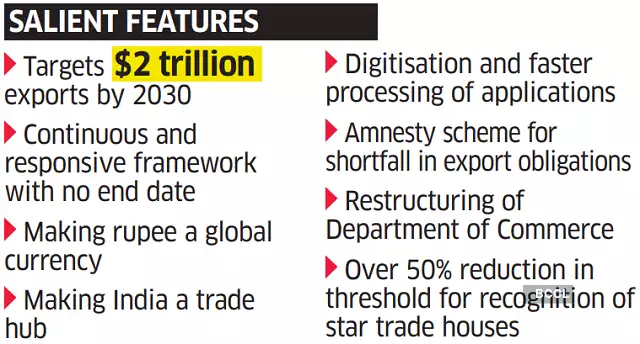Export Promotion Mission (EPM) 2025 – A strong focus on boosting Indian exports
India’s export promotion mission (EPM) is a crucial area for the UPSC examination, particularly within the context of the Indian economy. It is a new umbrella scheme of union government announced recently in the FY-26 Union Budget for boosting Indian Exports.
About Export Promotion Mission (EPM)
- Export Promotion Mission (EPM) is a new umbrella scheme announced in the FY26 Union Budget to consolidate various export promotion initiatives.
- The Union government has a strong focus on boosting exports to achieve ambitious targets, with the Foreign Trade Policy 2023 aiming to increase overall exports to $2 trillion by 2030.
- This mission involves various initiatives and schemes aimed at enhancing the competitiveness of Indian products and services in the global market.
- EPM has been allocated ₹2,250 crore in the FY26 Union Budget. The funds distributed under EPM are as following –
- ₹200 crore for the MAI (Market Access Initiative),
- ₹50 crore for LGD (Lab Grown Diamonds Scheme),
- The remaining amount is earmarked for IES (Interest Equalisation Scheme).
Objectives of EPM
- Increase Export Competitiveness: This mission aims to reduce the cost of doing business, improve logistics, and streamline procedures to make Indian exports more competitive internationally.
- Diversify Export Basket and Markets: Efforts are focused on diversifying the range of goods and services exported, as well as expanding into new and emerging markets to reduce dependence on traditional destinations.
- Promote E-commerce Exports: The mission recognizes the potential of digital trade and seeks to facilitate e-commerce exports by simplifying procedures, offering incentives, and establishing e-commerce hubs.
- Empower MSMEs: Micro, Small, and Medium Enterprises (MSMEs) are vital to India’s export growth, and this mission includes targeted interventions to support them, such as enhanced credit access, assistance in navigating non-tariff barriers, and capacity building programs, etc.
- Build Robust Trade Infrastructure: Improvements in logistics, including port connectivity, warehousing, and customs modernization, are essential to facilitate smoother and more efficient trade flows.
- Enabling Cross-Border Factoring: This mission setup mechanisms to make cross-border transactions smoother and mitigate risks associated with global trade for small exporters.
- Global Branding: It supports Indian brands in building International Recognition and accessing new markets through branding, outreach and development programs.
- Digital Enablement and Monitoring: It implement digitally enabled platforms for application and monitoring, ensuring transparency and accountability in the support provided.

Key Initiatives and Schemes
- Foreign Trade Policy (FTP) 2023 –
- This serves as the overarching framework for export promotion, moving away from an incentive-based approach to one focused on fostering an enabling ecosystem for self-reliance and global expansion.
- Remission of Duties and Taxes on Exported Products (RoDTEP) Scheme –
- This WTO-compliant scheme reimburses central, state, and local taxes and duties embedded in the cost of exported products, thereby boosting their competitiveness.
- Export Promotion Capital Goods (EPCG) Scheme –
- This scheme allows duty-free import of capital goods for export production, subject to the fulfillment of export obligations.
- Market Access Initiatives (MAI) Scheme –
- This provides financial assistance for export promotion activities like market studies, participation in international trade fairs, and brand promotion.
- Interest Equalization Scheme (IES) –
- This scheme offers interest rate subvention on pre and post-shipment rupee export credit, especially beneficial for MSMEs.
- Special Economic Zones (SEZs) –
- These zones are designed to attract investment and boost exports by offering a favourable business environment with benefits like tax exemptions and streamlined procedures.
- District as Export Hub (DEH) Initiative –
- This initiative focuses on identifying products with export potential in each district and developing the local export ecosystem.
- Niryat Bandhu Scheme –
- Provides training and guidance to individuals and firms new to international trade, equipping them with the necessary skills and knowledge.
Challenges Faced
- Global Trade Slowdown and Protectionism – Geopolitical uncertainties, trade protectionism, and a global economic slowdown pose significant challenges to export growth.
- High Logistics Costs and Infrastructure Bottlenecks – Inefficient logistics and inadequate infrastructure, including ports and transportation networks, increase costs and hinder the smooth flow of goods.
- Non-Tariff Barriers (NTBs) – Compliance with stringent quality standards, technical regulations, and certification requirements in key markets can be challenging for Indian exporters.
- Limited Access to Finance – Exporters, particularly MSMEs, often face difficulties accessing affordable export credit and financing.
- Sought Additional funds – Parliamentary Standing Committee sought additional funds for EPM as the committee observed that ₹2,250 crore is insufficient for the wide scope of the EPM, especially in light of high export-related costs and urged reassessment and fund enhancement at the revised estimates stage.
Way Forward
- Investing in Infrastructure: Continue upgrading logistics and trade infrastructure, including the use of multi-modal transport networks and digital tools to streamline processes.
- Addressing Non-Tariff Barriers: Develop domestic testing, certification, and quality assurance mechanisms aligned with international standards, and explore mutual recognition agreements with key trading partners.
- Enhanced Financial Support: Improve access to affordable export financing and credit, especially for MSMEs.
- Skill Development and Technology Adoption: Implement skill development programs and promote the adoption of technology, automation, and digitization in export-oriented industries.
- Exploring Joint Development Programs: Collaborate with other countries in sectors like space, semiconductors, and solar energy to improve India’s growth prospects and export potential.